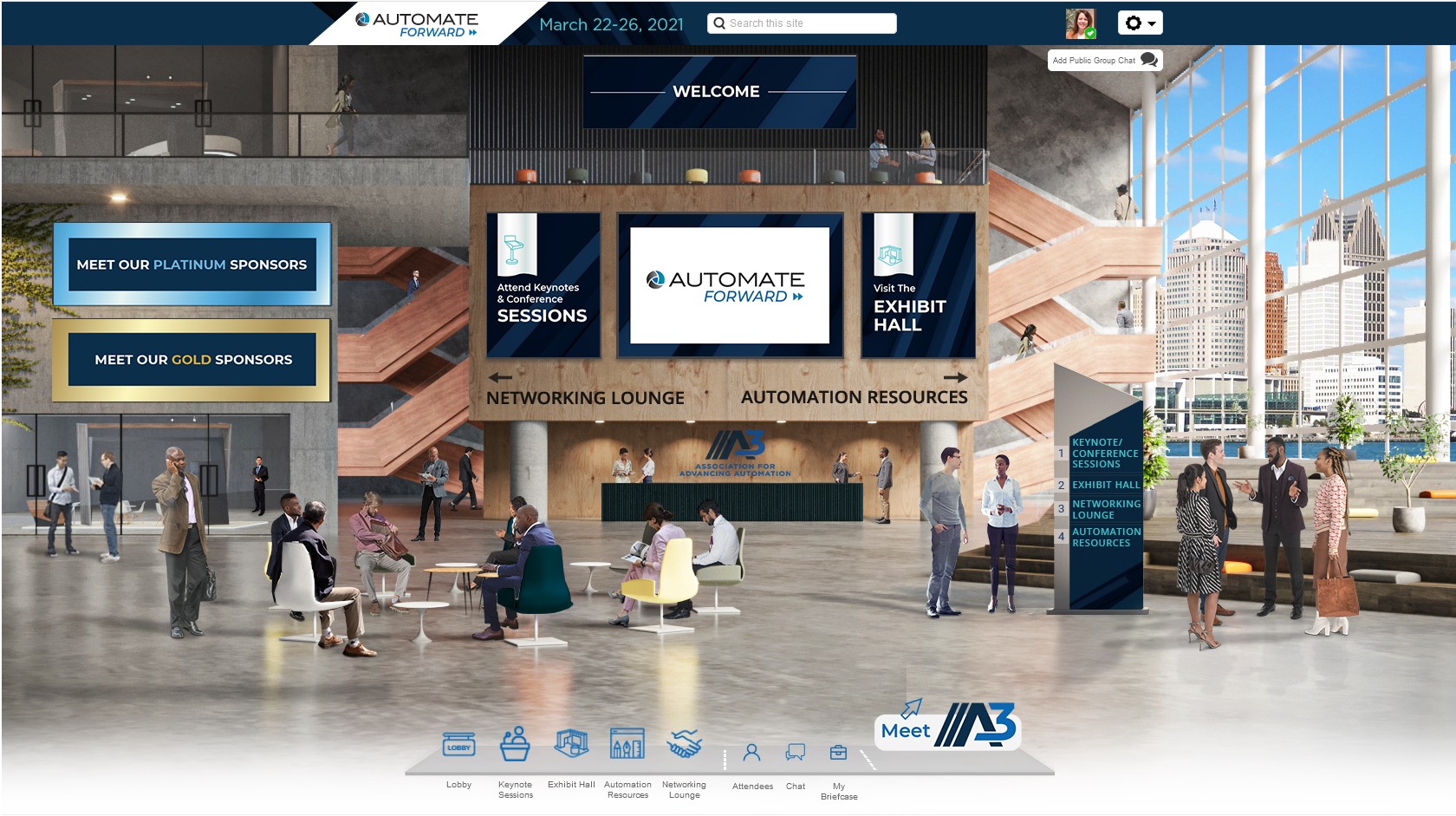Automate Forward, the virtual version of the biennial Automate conference and trade show, was held this week. The in-person event had been co-located with Promat at McCormick Place in Chicago for several years and would been held in Detroit for the first time. Automate Forward provided an opportunity for integrators and users to learn about robots and automation for a variety of applications.
Despite the virtual environment, the show still drew more than 270 exhibitors, including the top robotics suppliers serving the supply chain, logistics and manufacturing industries, according to the Association for Advancing Automation (A3). More than 40 keynote and panel sessions are available for viewing live or on demand. Since floor space wasn’t limited as it is at a traditional trade show, exhibitors could show as much of their products and services as they wanted on video, and they offered online chats with company representatives for further information.
A3 also announced that it is rebranding itself. On April 14, the four A3 associations—the Robotic Industries Association (RIA), AIA (Advanced Vision + Imaging), Motion Control & Motor Association (MCMA), and A3 Mexico—will converge into the Association for Advancing Automation.
Established and younger robotics companies alike showed off their wares in conjunction with Automate Forward.
ABB displays new logistics offerings
ABB Robotics introduced new robots to aid with logistics and a new monitoring system to ensure that robots are serviced before they break down.
The company’s IRB 390 FlexPacker flexible delta robot is designed to support customized packaging, vertical packing, and high-speed, high-variation sorting, as well as on-demand order picking in logistics and e-commerce fulfillment centers.
Consumers are starting to have multiple options for receiving goods, including home delivery, click and collect, in-store collection, and, more recently, robotic street kiosks. As a result, distribution centers need robots that can work with a variety of package sizes and shapes in the shortest time possible, ABB said. Operators need the right infrastructure for maximum flexibility that can pick and handle a wide variety of goods in the widest range of combinations and in the shortest possible time.
The IRB 390 FlexPacker robot is available as a four- and five-axis variant delta robot. It is 35% faster than the IRB 360-8/1130 FlexPicker, with a 45% increase in reachable volume and a payload of up to 15 kg, said ABB.
Distribution centers need their robots to be operational with minimal downtime to meet tight logistics schedules. ABB’s new Condition-Based Maintenance (CBM) service, announced at Automate Forward, is designed to create a preventive maintenance schedule for individual robots or fleets based on real-time operational data.
The service shares real-time data on robot operations to help identify any problems that could affect performance, including duty, speed, acceleration, and gearbox wear. These variables are compared against other robots in ABB’s worldwide robot database to calculate the likelihood and timeframe of a potential fault or failure.
“By providing greater predictability around maintenance and repair schedules, our condition-based maintenance service allows customers to get the most from their installed robots,” said Antti Matinlauri, the company’s head of product management. “Customers can now optimize their production efficiency by eliminating unexpected downtime caused by failures or delays in obtaining spare parts to fix a fault.”
“Users will also gain a better understanding of exactly which robots may have an increased risk of component failure, for exampl, if they are over-utilized compared to others in a production line, or if heavy payloads are causing the robot to operate outside of its recommended design parameters,” Matinlauri said.
Acieta unveils manufacturing cell
Acieta this week announced its FastLOAD CX1000 collaborative expandable robotic cell, which is mounted on a mobile platform so it can be quickly set up at different machines around a shop. The system is equipped with a FANUC 10 kg, 120V collaborative robotic arm and can be outfitted with up to three modular carts to handle a wide variety of parts.
“The FastLOAD CX1000 is pre-engineered to meet the most common machine tooling needs so it's ready for delivery and installation within one week,” said Jake Corning, Acieta product manager. “With the benefits of higher throughput and lower operating costs, users see a return on investment in six to 12 months, based on two shifts.”
The FastLOAD CX1000 has a small footprint and doesn’t require safety fencing, so it takes up approximately 80 percent less floor space than a traditional robotic cell, according to the company.
Dorner discusses ERT250 Pallet Conveyor
Also at Automate Forward 2021, Dorner hosted a webinar about its new Edge Roller Technology (ERT) pallet conveyor. The ERT250 is designed to provide low back pressure accumulation, non-contact zoning, and conventional transport—without a conventional conveyor belt. The open roller design can enable social distancing, is easily reconfigurable, and is rated for clean rooms, said Dorner.
FTA vision system intended for automotive assembly
ABB’s new Dynamic Assembly Pack for Final Trim and Assembly (FTA) uses real-time vision cameras on the robot gripper and arms. They are integrated with force-control sensors to enable the robot to precisely track the position of a car body as it enters the workstation for adding seats, doors and other parts.
The technology is designed to eliminate problems with vibration of automated guided vehicles (AGVs) or conveyors and variations in the speed of the production line. To compensate for any unexpected movements or vibrations, once the car body reaches a predefined position, the Compliant Vision Guidance (CVG) camera on the robot arm scans it for consistent reference points such as door edges, taking 30 to 40 images per second to determine whether the attachment point is where it should be and whether any adjustments are necessary.
About the Author
Follow Robotics 24/7 on Linkedin
Article topics
Email Sign Up




















